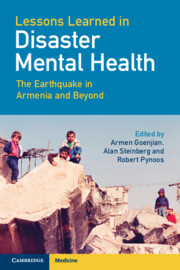Book contents
- Lessons Learned in Disaster Mental Health: The Earthquake in Armenia and Beyond
- Frontispiece
- Lessons Learned in Disaster Mental Health: The Earthquake in Armenia and Beyond
- Copyright page
- Contents
- Dedication
- Preface
- Contributors
- Chapter 1 The 1988 Spitak Earthquake in Armenia and the Implementation of the Psychiatric Outreach Program
- Chapter 2 Diaspora Therapists Working in the Earthquake Zone
- Chapter 3 Treatment Outcome among Early Adolescents Two Decades Post-Earthquake
- Chapter 4 Course and Predictors of PTSD and Depression among Not Treated Children and Adolescents over Two Decades
- Chapter 5 Conscience, Moral Injury, and Psychopathology
- Chapter 6 Natural Disasters and Relocation
- Chapter 7 Long-Term Course of PTSD and Depression Among Adults, Mediating and Moderating Factors in Recovery, and Current Trends for Treatment
- Chapter 8 How the Spitak Earthquake Contributed to our Understanding of the Genetics of PTSD and Associated Disorders
- Chapter 9 Epidemiology of Disasters and the Spitak Earthquake
- Chapter 10 Traumatic Stress Conceptual Framework
- Chapter 11 Memoirs of the Spitak Earthquake
- Chapter 12 Lessons Learned from the Spitak Earthquake and Other Catastrophic Disasters
- Index
- Plate Section (PDF Only)
- References
Chapter 9 - Epidemiology of Disasters and the Spitak Earthquake
Published online by Cambridge University Press: 20 May 2022
- Lessons Learned in Disaster Mental Health: The Earthquake in Armenia and Beyond
- Frontispiece
- Lessons Learned in Disaster Mental Health: The Earthquake in Armenia and Beyond
- Copyright page
- Contents
- Dedication
- Preface
- Contributors
- Chapter 1 The 1988 Spitak Earthquake in Armenia and the Implementation of the Psychiatric Outreach Program
- Chapter 2 Diaspora Therapists Working in the Earthquake Zone
- Chapter 3 Treatment Outcome among Early Adolescents Two Decades Post-Earthquake
- Chapter 4 Course and Predictors of PTSD and Depression among Not Treated Children and Adolescents over Two Decades
- Chapter 5 Conscience, Moral Injury, and Psychopathology
- Chapter 6 Natural Disasters and Relocation
- Chapter 7 Long-Term Course of PTSD and Depression Among Adults, Mediating and Moderating Factors in Recovery, and Current Trends for Treatment
- Chapter 8 How the Spitak Earthquake Contributed to our Understanding of the Genetics of PTSD and Associated Disorders
- Chapter 9 Epidemiology of Disasters and the Spitak Earthquake
- Chapter 10 Traumatic Stress Conceptual Framework
- Chapter 11 Memoirs of the Spitak Earthquake
- Chapter 12 Lessons Learned from the Spitak Earthquake and Other Catastrophic Disasters
- Index
- Plate Section (PDF Only)
- References
Summary
Disasters have short and long-term negative effects on a large array of physical and mental health outcomes. Epidemiology offers a variety of tools and methodologies for conducting a needs assessment, surveillance, and longitudinal research aimed at identifying adverse outcomes and developing strategies for preventing disease and promoting health. The application of epidemiological methods has advanced our understanding of pervasive morbidity and mortality often experienced in the aftermath of disasters. Findings from epidemiological studies have implications for improving the allocation of resources and developing interventions targeting these adverse outcomes. In this chapter, we briefly highlight developments in the epidemiology of disasters. We present common study designs employed in disaster response and research and provide examples of applications of these methods in studying the consequences of the 1988 Spitak earthquake in Armenia. The chapter concludes with a brief discussion of recent developments in research methodology and their potential implications for disaster researchers and public health practitioners focusing on prevention and mitigation.
- Type
- Chapter
- Information
- Lessons Learned in Disaster Mental HealthThe Earthquake in Armenia and Beyond, pp. 152 - 161Publisher: Cambridge University PressPrint publication year: 2022

